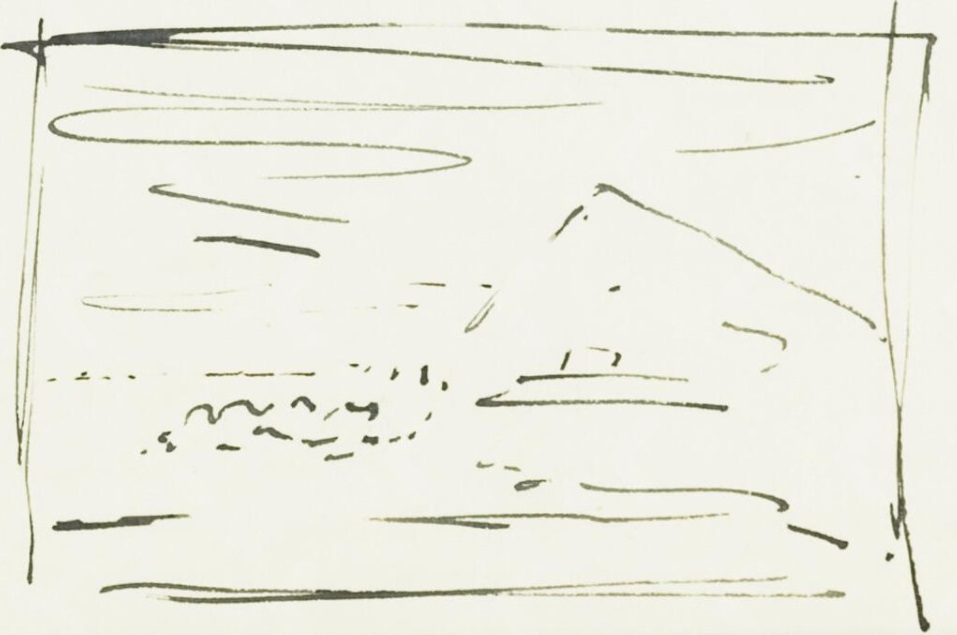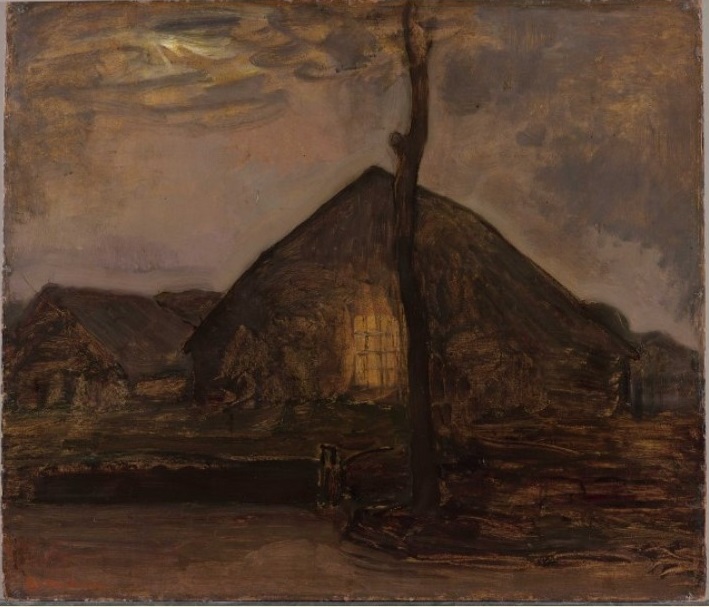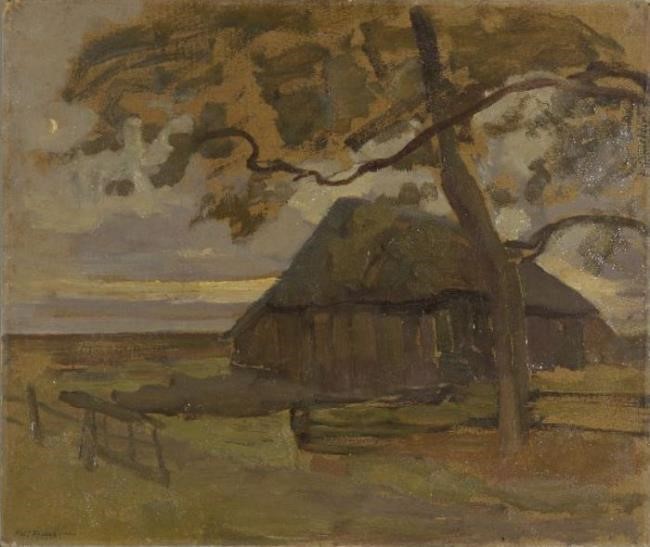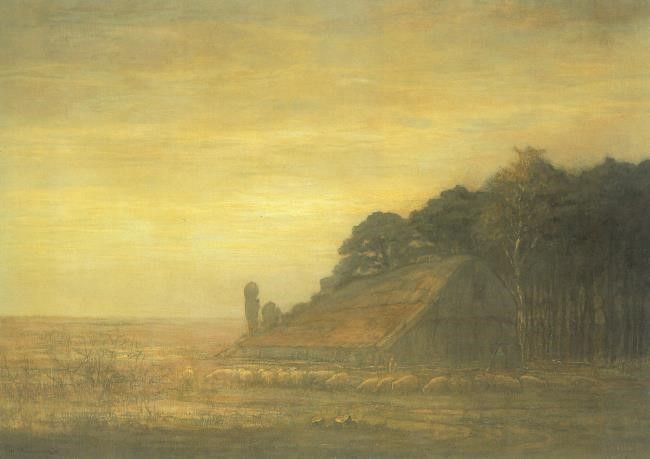by Wietse Coppes

Unlike Vincent van Gogh, Piet Mondrian hardly ever illustrated his letters with sketches. On a total of about 1,700 letters, sketches are only to be found on a dozen of them. One of these illustrated letters is the subject of this post. Containing only a rough sketch, it nevertheless lead to the identification of a corresponding painting. Due to the fact that Mondrian provides some background information on the sketch, the limited provenance data of the work could also be supplemented.

Sheepfolds
During his lifetime Mondrian spoke but rarely of artists who served as an inspiration. Towards the end of his life he shared recollections with friend and curator James Johnson Sweeney of a visit to painter Hendrik Willem Mesdag’s collection. What Mondrian saw there included work by the French painter Charles-François Daubigny, which greatly appealed to him. Daubigny belonged to the Painters of Barbizon; artists who had abandoned their studios in favour of painting plein-air. A number of works by Daubigny in Mesdag’s collection, such as Moonlight from approximately 1875 and Sheepfold at daybreak from 1861, are excellent examples of this. Their sketchy nature and schematic composition, together with the solid rendering of forms, would certainly have appealed to Mondrian around the turn of the century. Was it Daubigny’s painting that inspired Mondrian to paint sheepfolds? Although it is unclear in what year Mondrian saw Daubigny’s works at Mesdag’s, around 1907 the sheepfold motif appears in a number of works he made during a stay in Twente.

Particularly reminiscent of the work of Daubigny, is the accomplished drawing called Avond (‘Evening’) (A545) from 1906. Mondrian drew a moon-lit heath landscape, with on the right a group of trees and in front of it the sheepfold: a barn where sheep spend the night after a day’s grazing. However, in Avond, the sheep, which in Daubigny’s painting figure so dominantly, are absent – in contrast to Sheepfold with flock of sheep (A548), which Mondrian painted in 1907. In this work a sheepfold is the main focus, this time painted against a pale yellow evening sky. The herd of grazing sheep is in front of the barn, more or less as it is in Daubigny’s painting. Provenance data relating to this work hardly exist. The only information Robert Welsh offers in his part of Piet Mondrian. Catalogue Raisonné is that at some point it came into possession of American gallery owner Sidney Janis, in whose collection the work still featured when the catalogue was published in 1998.

‘Quite sellable’
While annotating Mondrian’s correspondence, we stumbled across a letter that Mondrian wrote at the beginning of April 1916 to Amsterdam estate agent Salomon Bernard (‘Sal’) Slijper. Six months earlier Mondrian had first met Slijper, who was 12 years his junior, and who fairly soon afterwards started buying work by Mondrian. The initially close friendship between the two continued to exist well into the thirties and Slijper was to become the most important collector of Mondrian’s work. Although Slijper later stated how, once he had grown accustomed to it, he developed a penchant for Mondrian’s abstract work, his collection primarily contained examples from Mondrian’s earlier, naturalistic phase. Apart from being a good friend with whom Mondrian shared a passion for dancing, women and beautiful clothes, Slijper also turned out to be a convenient outlet for earlier work Mondrian himself did not consider to be his best. This becomes obvious from a letter in which Mondrian writes: ‘That painting that S. Maris sold to that gentleman could be mine after all. I once sold a mill to him, which he then loaned to me to include in an exhibition. There I was offered 300 guilders for it, so I asked S. Maris if I could give him some other things in return. He was kind enough to oblige so I gave him two sizeable paintings which were quite sellable but not much to my liking. One was a heath with a barn and a couple of sheep. Something like this,” which is followed by a sketch [ill. 1].
Mondrian’s rough sketch could be a reference to a number of paintings [ill.2-4]. From his description it would seem, however, that the work must contain sheep, be fairly large, and ‘quite sellable’. If we consider these aspects then there is really only one viable candidate, the previously discussed Sheepfold with flock of sheep (A548) [ill.4]. The size of this work is 99 x 141 centimetres, which makes it one of the larger works Mondrian produced. The studies in oil paint [ill.2 and 3] of the sheepfold are considerably smaller in size and by their sketchy nature also less suitable for commercial purposes. That the painting be sellable was important because Simon Maris was an active art dealer. He would have been more than happy to accommodate his good friend Mondrian by selling off some of his work. It seems likely that a percentage of the selling price would subsequently find its way to Mondrian. For that reason it was in his own interest to make sure that work he passed on to Maris had commercial potential. This would be much more likely with a high-quality painting than with a mere sketch in oil paint.
From this it may be concluded that at some point before April 1916 Mondrian and Maris negotiated an exchange in which Sheepfold with flock of sheep was included. When and to whom Maris next sold the work, and how it eventually ended up in the collection of Sidney Janis remains unclear. Even so, the provenance data of this painting can be further extended, which contributes to our growing insight into the spread of Mondrian’s oeuvre.